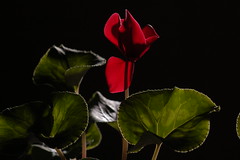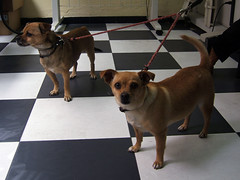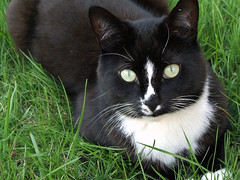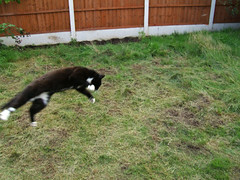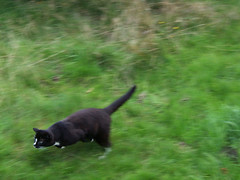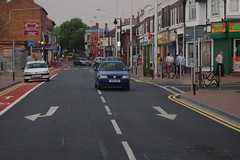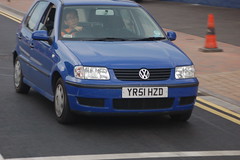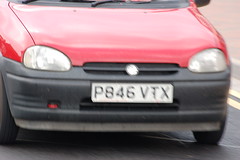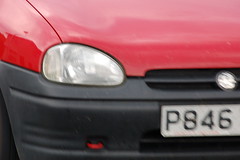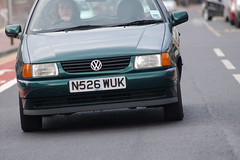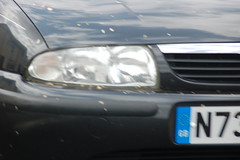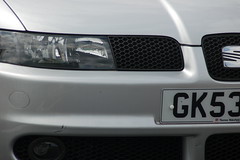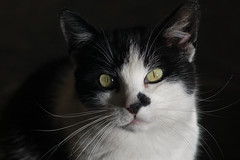
"You've attached what to your Nikon D50?"
As part of my ongoing project to hamstring my Nikon D50 digital SLR, I tried it with my old 100mm f2.8 E series manual focus lens. The series E lenses were plastic-bodied AIS lenses designed for the budget Nikon EM SLR back in the 1970's; I bought one years ago for my manual Nikon FM camera, as snobbery among collectors about the plastic construction meant you could get these excellent lenses at knock-down prices second-hand (the lens elements are all glass, of course, and very good too).
The first effect of fitting a manual lens to the D50 is that the metering system is completely disabled; without the CPU inside even the oldest AF-Nikkors, you get nothing, neither matrix metering, centre-weighted nor spot. The aperture readout on the top plate LCD and in the viewfinder reads "--" and none of the automatic exposure modes will work. You have to switch to Manual exposure mode, and, unusually for the D50, set the aperture via the aperture ring on the lens.
For a metered exposure, you'd need either a handheld incident meter or a second camera. Luckily, I'd used an old non-metered Rolleiflex TLR for a number of years, and had got used to 'guesstimating' exposure. A great advantage of digital is that I could take test shots and adjust accordingly. Much to my satisfaction, my guesses were mostly within about a stop of the right result.
The first effect of fitting a manual lens to the D50 is that the metering system is completely disabled; without the CPU inside even the oldest AF-Nikkors, you get nothing, neither matrix metering, centre-weighted nor spot. The aperture readout on the top plate LCD and in the viewfinder reads "--" and none of the automatic exposure modes will work. You have to switch to Manual exposure mode, and, unusually for the D50, set the aperture via the aperture ring on the lens.
For a metered exposure, you'd need either a handheld incident meter or a second camera. Luckily, I'd used an old non-metered Rolleiflex TLR for a number of years, and had got used to 'guesstimating' exposure. A great advantage of digital is that I could take test shots and adjust accordingly. Much to my satisfaction, my guesses were mostly within about a stop of the right result.
Focussing is, naturally, manual, but I was pleasantly surprised to find the D50's electronic rangefinder still works; this shows a green dot in the left-hand corner of the viewfinder when the subject in the focussing brackets is sharp. You can go a bit cross-eyed trying to keep the centre focus brackets in position while monitoring the in-focus dot, but it works well enough; sadly, the D50 doesn't possess the useful direction triangles (telling you which way to turn the focussing ring) that were present in the finders of my old F4 and F801s. Given the speed and accuracy of the D50's AF, I can see why this is; I only use MF as a way of locking focus or when setting focus to a given distance for depth focussing* - either way, I almost never fine-focus manually.
I had thought that the focussing screen for the D50 was fixed, but since Katz Eye Optics make a split-prism screen with microprism collar for the D50, I guess it must be interchangeable. I'm not sure if Nikon make a compatible manual focussing screen, but there evidently is a third-party option if you were thinking of using manual focus a lot.
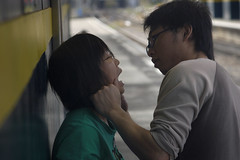
Grab shot - it was about 1 2/3 stops under, but rescuable in Photoshop - like slide film, digital images respond better to slight underexposure.
So results; well, it wasn't as convenient as shooting with an AF lens, obviously, but it was a lot easier than I'd feared. Although it was a bit awkward to use, having the electronic rangefinder for reassurance made a big difference. I was surprised that I managed to get decent shots of a moving target like my mum's cat, and even a grabbed candid (above) using this camera/lens combination.
Not being able to meter the exposure slowed things right down (having an incident meter to hand would have made a lot of difference) but given a bit of experience and the ability to make test shots, it was surmountable, to the extent that if you predominantly shot static subjects (i.e., still life or plants) under reasonably controlled conditions, you might not even miss having a meter. If you were shooting at night with (auto) flash and a pre-focussed wide-angle manual lens, you could also bypass focus/exposure issues.
The D50 obviously isn't intended for use with manual focus lenses, but, depending on what you shoot and how you shoot it, you might be able to keep on using an old favourite. A couple of caveats though; bear in mind that the D50's chip is smaller than a 35mm film frame, so multiply the focal length of your lenses by 1.5 to get the new angle of view - in practise this means that your wide-angle lenses will become less wide-angle, in fact even lenses as wide as 28mm really stop being wide-angle at all.
Secondly, not all old Nikkor lenses can be attached to the D50 - in particular, there seems to be a long list of exclusions among the teleconverters, bellows and PC-shift lenses. I'd strongly advise checking lens types and serial numbers with Nikon (or seeing if your local dealer will let you look in the back of a D50 manual) before buying.
*setting the focus for a given distance with a reasonably small aperture and using depth-of-field to keep subjects within a given range in focus.
